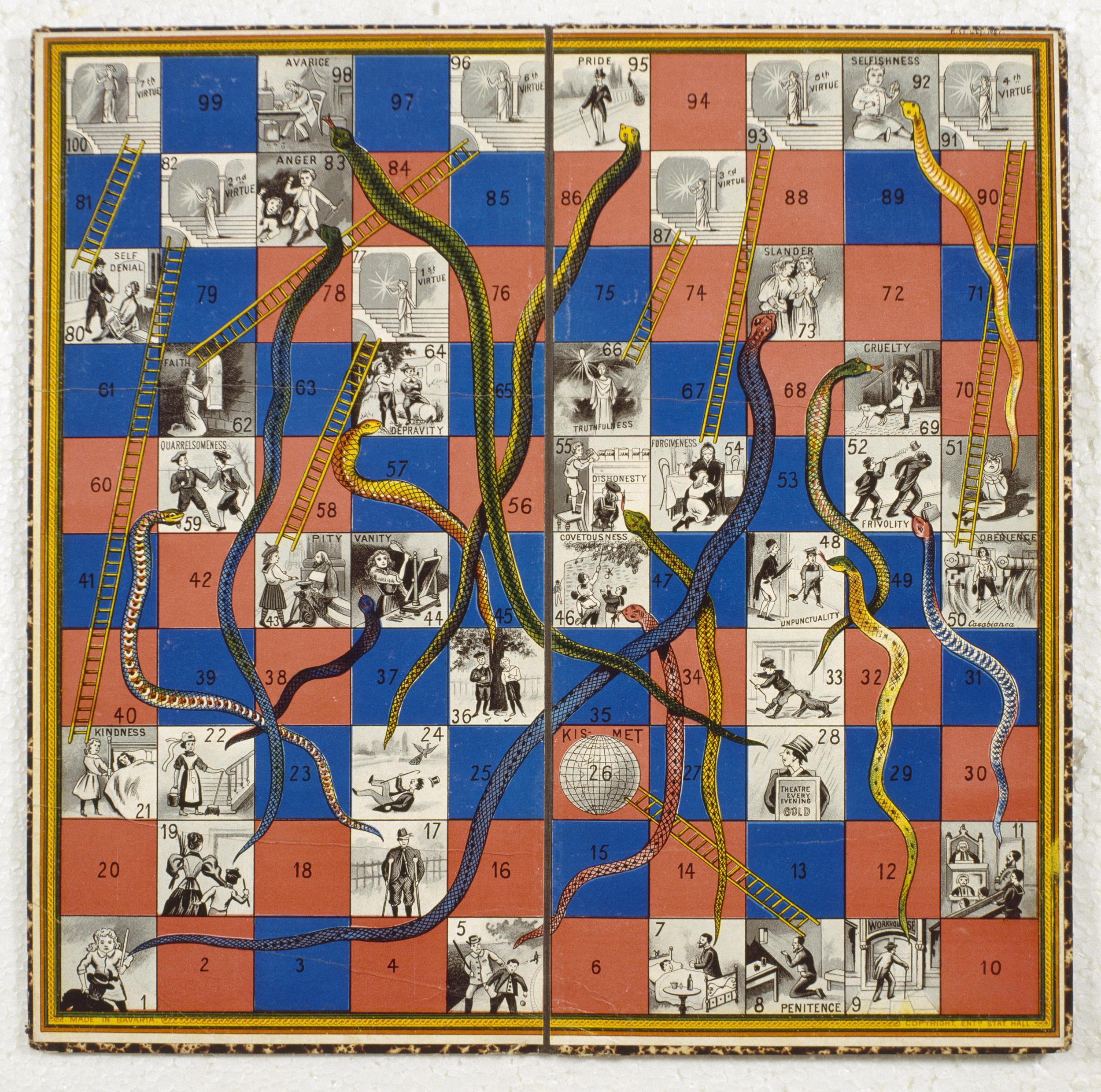
By the 1940s very few pictorial references to Indian culture remained, due to the economic demands of the war and the collapse of British rule in India. The décor and art of the early English boards of the 20th century reflect this relationship. The association of Britain's snakes and ladders with India and gyan chauper began with the returning of colonial families from one of Britain's most important imperial possessions, India. This concept of equality signifies the cultural ideal that for every sin one commits, there exists another chance at redemption. While the Indian version of the game had snakes outnumbering ladders, the English counterpart was more forgiving as it contained each in the same amount. Squares of Fulfilment, Grace and Success were accessible by ladders of Thrift, Penitence and Industry and snakes of Indulgence, Disobedience and Indolence caused one to end up in Illness, Disgrace and Poverty. When the game was brought to England, the Indian virtues and vices were replaced by English ones in hopes of better reflecting Victorian doctrines of morality.

Presumably, reaching the last square (number 100) represented the attainment of Moksha (spiritual liberation). The number of ladders was less than the number of snakes as a reminder that a path of good is much more difficult to tread than a path of sins. The morality lesson of the game was that a person can attain salvation ( Moksha) through doing good, whereas by doing evil one will be reborn as lower forms of life. The ladders represented virtues such as generosity, faith, and humility, while the snakes represented vices such as lust, anger, murder, and theft. The board was covered with symbolic images, the top featuring gods, angels, and majestic beings, while the rest of the board was covered with pictures of animals, flowers and people. The game has also been interpreted and used as a tool for teaching the effects of good deeds versus bad. The underlying ideals of the game inspired a version introduced in Victorian England in 1892.

It emphasized destiny, as opposed to games such as pachisi, which focused on life as a mixture of skill (free will ) and luck. It was also associated with traditional Hindu philosophy contrasting karma and kama, or destiny and desire. The game was popular in ancient India by the name Moksha Patam. Gyan chauper/ jnan chauper (game of wisdom), the version associated with the Jain philosophy encompassed the concepts like karma and Moksha. Gyan chaupar ( Jain version of the game), National Museum, New Delhi The game made its way to England and was sold as "Snakes and Ladders", then the basic concept was introduced in the United States as Chutes and Ladders (an "improved new version of England's famous indoor sport" ) by game publisher Milton Bradley Company in 1943. Snakes and ladders originated in India as part of a family of dice board games that included gyan chauper and pachisi (known in English as Ludo and Parcheesi). A single die is rolled to determine random movement of a player's token in the traditional form of play two dice may be used for a shorter game. Each player is represented by a distinct game piece token.

Boards have snakes and ladders starting and ending on different squares both factors affect the duration of play. The size of the grid varies, but is most commonly 8×8, 10×10 or 12×12 squares. The game is also sold under other names such as Chutes and Ladders, Bible Ups and Downs, etc., some with a morality motif a morality Chutes and Ladders was published by the Milton Bradley Company starting from 1943. The historic version had its roots in morality lessons, on which a player's progression up the board represented a life journey complicated by virtues (ladders) and vices (snakes). The game is a simple race based on sheer luck, and it is popular with young children.

The object of the game is to navigate one's game piece, according to die rolls, from the start (bottom square) to the finish (top square), helped by climbing ladders but hindered by falling down snakes. A number of "ladders" and "snakes" are pictured on the board, each connecting two specific board squares. It is played on a game board with numbered, gridded squares. Snakes and ladders, known originally as Moksha Patam, is an ancient Indian board game for two or more players regarded today as a worldwide classic. Game of Snakes and ladders, gouache on cloth (India, 19th century)


 0 kommentar(er)
0 kommentar(er)
